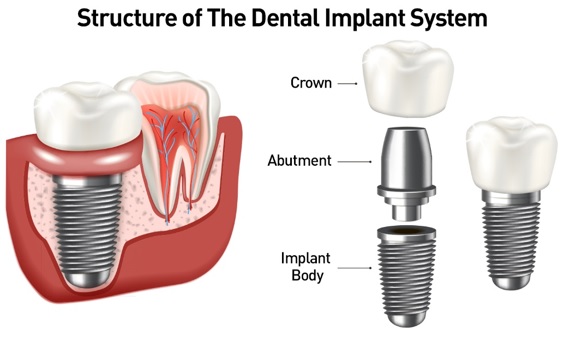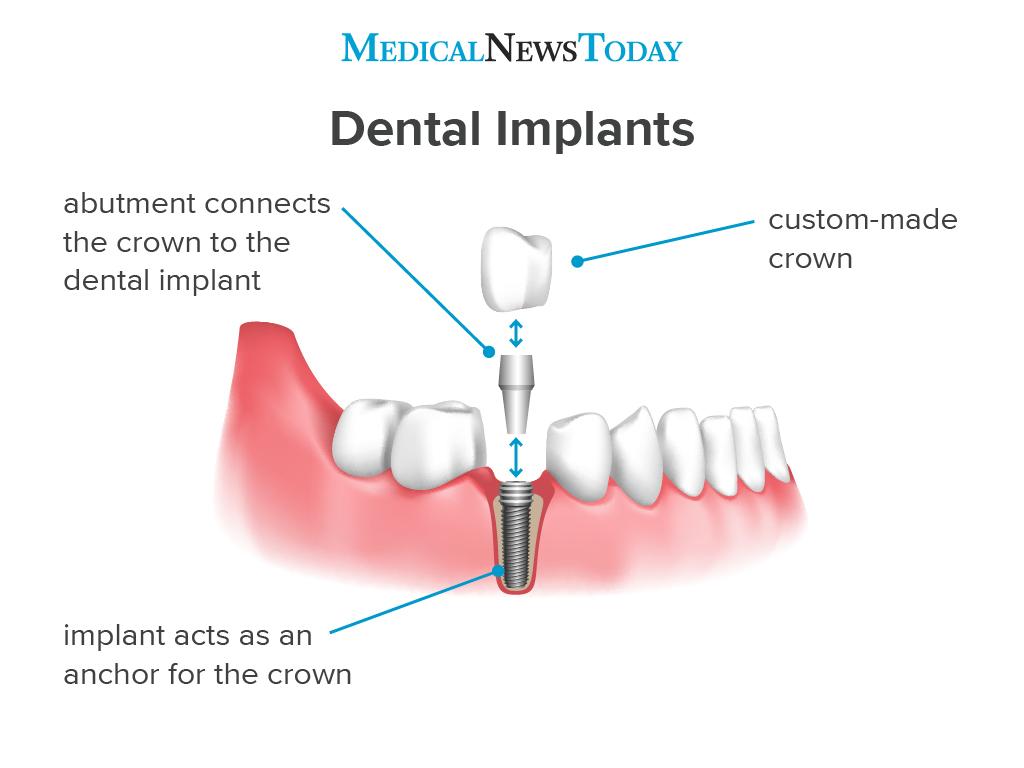The Ultimate Guide To Dental Implants
The Ultimate Guide To Dental Implants
Blog Article
Not known Factual Statements About Dental Implants
Table of ContentsDental Implants Can Be Fun For AnyoneThe Definitive Guide for Dental ImplantsDental Implants Fundamentals ExplainedThings about Dental Implants
are medical devices surgically implanted into the jaw to restore a person's capacity to eat or their appearance. They supply support for synthetic (fake) teeth, such as crowns, bridges, or dentures. When a tooth is lost due to injury or illness, an individual can experience difficulties such as fast bone loss, defective speech, or changes to chewing patterns that result in discomfort.
Structure of The Dental Implant System selecting dental implants, speak to your oral service provider regarding the potential benefits and threats, and whether you are a candidate for the treatment. Things to consider: Your overall health is a crucial consider figuring out whether you are an excellent candidate for dental implants, for how long it will require to heal, and how long the implant may remain in area.
Smoking cigarettes may impact the recovery procedure and reduce the lasting success of the implant. The healing procedure for the implant body might take a number of months or longer, during which time you normally have a short-lived abutment instead of the tooth. the oral implant treatment: Thoroughly follow the oral hygiene directions provided to you by your dental service provider.
The Buzz on Dental Implants
Implant failing can result in the requirement for another operation to fix or change the implant system. Brings back the capacity to eat Restores cosmetic appearance Helps maintain the jawbone from reducing as a result of bone loss Protects the wellness of the bordering bone and gums Assists maintain adjacent (close-by) teeth secure Boosts lifestyle Damages to bordering all-natural teeth throughout dental implant positioning Injury to the surrounding tissues throughout surgical procedure, such as sinus opening Injury during surgery (for instance, fracture of surrounding jawbone) Insufficient feature, such as seeming like the teeth do not bite together normally An experience that the tooth hangs or twisting in position arising from an abutment screw loosening up Implant body failure (looseness of the dental implant body) because of systemic infection, which may be more probable in patients with unrestrained diabetes mellitus as a result of regional infection in bone and gums supporting the implant body as a result of delayed healing, which may be most likely in patients that smoke Trouble cleansing the gums around the implant, leading to bad dental health Unattended gum condition Post-surgical numbness as a result of nerve impingement or damages Constantly inform health treatment providers and imaging technicians that you have dental implants prior to any type of magnetic resonance imaging (MRI) or x-ray procedures.
FDA is not familiar with any kind of unfavorable occasions reported for MRI or x-ray treatments with oral implants. Oral implants systems are usually constructed from products that adhere to global agreement requirements of the International Company for Standardization (ISO) click to read more or ASTM International. These criteria have details of what makes a secure material.
Dental dental implant systems are evaluated according to international consensus criteria. Biocompatibility testing, to show that bodily contact with the tool does not trigger difficulties like inflammation or sensitive response, is part of the analysis that helps ensure the products in the dental implant system are safe and do not cause damaging impacts when implanted in people.

All about Dental Implants
Some individuals are not eligible for oral implant surgical treatment. It is for dental doctors to operate individuals with: intense illnessuncontrollable metabolic diseasebone or soft tissue illness or infectionIf these concerns are solved, a person can have the surgical procedure. Dental Implants. In, dental cosmetic surgeons refrain from operating individuals with: If individuals with any one of the above undergo oral implant surgical treatment, there is a greater threat of the implant falling short
Some individuals have a jawbone irregularity that stops adequate bone for an implant from developing. In such situations, a specialist may need to perform a ridge modification. This includes lifting the gum tissue to reveal the area of flawed bone. The cosmetic surgeon will certainly after that utilize a bone or bone replacement to repair and build up the location.
Dental implant surgery is a personalized procedure. It's not the exact same for everyone. The following provides a general overview of what you can anticipate your dental practitioner, dental specialist, periodontist or prosthodontist to do: Put the dental implant surgically. Offer you time to heal. Affix the post and last crown, bridge or denture.
Next off, your surgeon will carefully position the dental implant into your jaw. Your surgeon will my review here certainly reposition your gums and close the incision with stitches (Dental Implants). If your dental implant is near the front of your mouth, your dental expert will make a short-term tooth for you to put on up until you heal. In this way, you will not have a void in your smile while you recoup.
The Only Guide to Dental Implants
Throughout the recovery phase, your jawbone should fuse to the dental implant. This process can take anywhere from 3 to 9 months.
When your implant heals, your dental expert can connect the abutment (little connector post) and your last repair (crown, bridge or denture). This usually takes concerning one hour to finish and might need a 2nd minor surgical procedure. You should not feel any discomfort throughout your dental implant procedure because your company will use drug to numb your gums.
Report this page